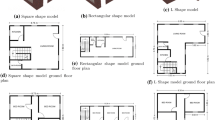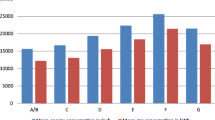Abstract
The hydronic thermal barrier (HTB) makes the building envelope gradually regarded as a multi-functional element, which is an opportunity to transform thermal insulation solutions from high to zero-carbon attributes. However, inappropriate design, construction, and operation control may lead to issues like low efficiency and high investment, and even the opposite technical effects. In this paper, a comprehensive uncertainty and variable ranking analysis is numerically conducted to explore the influence mechanism of twelve risk variables on three types and five thermal performance indexes under summer conditions. The uncertainty analysis results showed that the correct application of HTB could significantly reduce the heat gain that needs to be handled by the traditional air-conditioning system and even have the technical effect of auxiliary cooling if the variables are appropriately selected. The comprehensive influences of water temperature, room temperature, charging duration, and thermal conductivity of the HTB layer were in the first 1/3 range. Among them, the first two variables were identified as the two most influential variables, and they had a significant mutual restriction relationship in all other four indexes except for the exterior surface cold loss. The recommended charging duration was not less than eight hours in practical application, and the HTB layer with a higher thermal conductivity value but less than 3.3 W/(m·°C) was suggested. Besides, the climate zone was no longer the most influential variable affecting the mean radiant temperature of the interior surface due to the combined effects of HTB and static thermal insulation measures. In addition, pipe spacing should preferably be selected between 100 and 250 mm to help form a continuous thermal buffer zone inside the building envelope.
Similar content being viewed by others
Abbreviations
- A :
-
area (m2)
- C :
-
volume (m3)
- c p :
-
specific heat (J/(kg·°C))
- h :
-
convective heat transfer coefficient (W/(m2·°C))
- I :
-
intensity of solar radiation (W/m2)
- n :
-
number of input variables
- Q ex :
-
total cold loss (kWh)
- Q IC :
-
total injected low-grade cold energy (MJ)
- Q in :
-
total cooling load (kWh)
- Q s :
-
total stored cold energy (MJ)
- q :
-
heat flux (W/m2)
- q ex :
-
instantaneous cooling loss (kWh)
- q in :
-
instantaneous cooling load (kWh)
- q pipe :
-
cold charging rate (W)
- q rad-ex :
-
exterior radiative heat flux (W/m2)
- q rad-in :
-
interior radiative heat flux (W/m2)
- R :
-
thermal resistance (°C/W)
- R 2 :
-
coefficient of determination
- S φ :
-
source term
- S i :
-
first-order effect indices
- SRCi :
-
standardized regression coefficient
- S Tí :
-
total effect indices
- T :
-
temperature (°C)
- T ex :
-
exterior surface temperature (°C)
- Ti:
-
indoor set-point (°C)
- T in :
-
interior surface temperature (°C)
- T o :
-
outdoor temperature (°C)
- T sol-air :
-
sol-air temperature (°C)
- t sum :
-
overheating duration (h)
- U :
-
heat transfer coefficient (W/(m2·°C))
- V :
-
total variance
- V i :
-
variance of the the ith variable
- V ji :
-
variance of interaction term
- v :
-
outdoor wind speed (m/s)
- Γ φ :
-
diffusion coefficient
- λ :
-
thermal conductivity coefficient (W/(m·°C))
- μ s :
-
solar absorptance
- ρ :
-
density (kg·m3)
- τ :
-
time (s)
- φ :
-
common variable
- CD:
-
charging duration
- COD:
-
cumulative overheating duration
- CZ:
-
climate zone
- ECL:
-
exterior surface cold loss
- ED:
-
energy density
- GSA:
-
global sensitivity analysis
- HT:
-
heat source temperature
- HTB:
-
hydronic thermal barrier
- ICL:
-
interior surface cooling load
- IS:
-
indoor set-point
- Msc:
-
specific heat of hydronic thermal barrier layer
- Mtc:
-
thermal conductivity coefficient of the hydronic thermal barrier layer
- OT:
-
orientation
- PD:
-
pipe diameter
- PL:
-
pipe location
- PS:
-
pipe spacing
- Ptc:
-
thermal conductivity of embedded pipe
- RA:
-
solar absorptance
- SRC:
-
standardized regression coefficients
- TEH:
-
total extracted heat
- TGP:
-
treed Gaussian process
- UA:
-
uncertainty analysis
References
Bak J, Yoon S (2021). Dwelling infiltration and heating energy demand in multifamily high-rise and low-energy buildings in Korea. Renewable and Sustainable Energy Reviews, 148: 111284.
Barbosa R, Vicente R, Santos R (2015). Climate change and thermal comfort in Southern Europe housing: A case study from Lisbon. Building and Environment, 92: 440–451.
Blanco JM, Arriaga P, Rojí E, et al. (2014). Investigating the thermal behavior of double-skin perforated sheet façades: Part A: Model characterization and validation procedure. Building and Environment, 82: 50–62.
CABR (2010). JGJ26-2010: Design Standard for Energy Efficiency of Residential Buildings in Severe Cold and Cold Zones. China Academy of Building Research (CABR). Beijing: China Building and Industry Press.
CABR (2012). GB50736-2012. Design Code for Heating Ventilation and Air Conditioning of Civil Buildings. China Academy of Building Research (CABR). Beijing: China Building and Industry Press.
Camci M, Karakoyun Y, Acikgoz O, et al. (2022). An experimental study on the heat transfer characteristics over a radiant cooled wall exposed to mixed and forced convection driven by displacement ventilation. International Communications in Heat and Mass Transfer, 135: 106122.
Chen S, Yang Y, Olomi C, et al. (2020). Numerical study on the winter thermal performance and energy saving potential of thermo-activated PCM composite wall in existing buildings. Building Simulation, 13: 237–256.
Chen S, Chang T, Yang Y, et al. (2021). Summer thermal performance study on pipe-embedded PCM composite wall in existing buildings. Journal of University of Science and Technology of China, 51: 840–856.
Cui H, Overend M (2019). A review of heat transfer characteristics of switchable insulation technologies for thermally adaptive building envelopes. Energy and Buildings, 199: 427–444.
DOE (2015). A common definition for zero energy buildings. US Department of Energy (DOE). Available at https://www.energy.gov/eere/buildings/downloads/common-definition-zero-energy-buildings. Accessed 3 Dec 2021.
Garg H, Pandey B, Saha SK, et al. (2018). Design and analysis of PCM based radiant heat exchanger for thermal management of buildings. Energy and Buildings, 169: 84–96.
Ibrahim M, Wurtz E, Anger J, et al. (2017). Experimental and numerical study on a novel low temperature façade solar thermal collector to decrease the heating demands: A south-north pipe-embedded closed-water-loop system. Solar Energy, 147: 22–36.
Kalús D, Gašparík J, Janík P, et al. (2021). Innovative building technology implemented into facades with active thermal protection. Sustainability, 13: 4438.
Kisilewicz T, Fedorczak-Cisak M, Barkanyi T (2019). Active thermal insulation as an element limiting heat loss through external walls. Energy and Buildings, 205: 109541.
Krajčík M, Šikula O (2020). The possibilities and limitations of using radiant wall cooling in new and retrofitted existing buildings. Applied Thermal Engineering, 164: 114490.
Krajčík M, Šimko M, Šikula O, et al. (2021a). Thermal performance of a radiant wall heating and cooling system with pipes attached to thermally insulating bricks. Energy and Buildings, 246: 111122.
Krajčík M, Arıcı M, Šikula O, et al. (2021b). Review of water-based wall systems: Heating, cooling, and thermal barriers. Energy and Buildings, 253: 111476.
Krzaczek M, Kowalczuk Z (2011). Thermal barrier as a technique of indirect heating and cooling for residential buildings. Energy and Buildings, 43: 823–837.
Krzaczek M, Florczuk J, Tejchman J (2019). Improved energy management technique in pipe-embedded wall heating/cooling system in residential buildings. Applied Energy, 254: 113711.
Loonen RCGM, Trčka M, Cóstola D, et al. (2013). Climate adaptive building shells: State-of-the-art and future challenges. Renewable and Sustainable Energy Reviews, 25: 483–493.
Ma P, Wang L, Guo N (2015). Energy storage and heat extraction—From thermally activated building systems (TABS) to thermally homeostatic buildings. Renewable and Sustainable Energy Reviews, 45: 677–685.
Mao J, Yang JH, Afshari A, et al. (2017). Global sensitivity analysis of an urban microclimate system under uncertainty: Design and case study. Building and Environment, 124: 153–170.
MOHURD (2022). GB/T 55015-2021. General Code for Building Energy Conservation and Renewable Energy Utilization. Ministry of Housing and Urban-rural Development of China (MOHURD). Available at https://www.mohurd.gov.cn/gongkai/fdzdgknr/zfhcxjsbwj/202110/20211013_762460.html. Accessed 3 Dec 2021.
Nagaoka A, Ota Y, Sakai K, et al. (2021). Performance evaluation and spectrum-based analysis of a wall-mounted photovoltaic system for zero-energy building. Renewable Energy, 174: 147–156.
Ni S, Zhu N, Zhang Z, et al. (2021). The operational performance of net zero energy wooden structure building in the severe cold zone: A case study in Hailar of China. Energy and Buildings, 257: 111788.
Niu F, Yu Y (2016). Location and optimization analysis of capillary tube network embedded in active tuning building wall. Energy, 97: 36–45.
O’Hegarty R, Kinnane O, McCormack SJ (2017). Parametric investigation of concrete solar collectors for façade integration. Solar Energy, 153: 396–413.
Salata F, Golasi I, Domestico U, et al. (2017). Heading towards the nZEB through CHP+HP systems. A comparison between retrofit solutions able to increase the energy performance for the heating and domestic hot water production in residential buildings. Energy Conversion and Management, 138: 61–76.
Saltelli A, Ratto M, Andres T, et al. (2008). Global Sensitivity Analysis. The Primer. Chichester, UK: John Wiley & Sons.
Schiavoni S, D’Alessandro F, Bianchi F, et al. (2016). Insulation materials for the building sector: A review and comparative analysis. Renewable and Sustainable Energy Reviews, 62: 988–1011.
Schmelas M, Feldmann T, Bollin E (2017). Savings through the use of adaptive predictive control of thermo-active building systems (TABS): A case study. Applied Energy, 199: 294–309.
Shen C, Li X (2016). Dynamic thermal performance of pipe-embedded building envelope utilizing evaporative cooling water in the cooling season. Applied Thermal Engineering, 106: 1103–1113.
Shen C, Li X (2017). Energy saving potential of pipe-embedded building envelope utilizing low-temperature hot water in the heating season. Energy and Buildings, 138: 318–331.
Silva T, Vicente R, Amaral C, et al. (2016). Thermal performance of a window shutter containing PCM: Numerical validation and experimental analysis. Applied Energy, 179: 64–84.
Šimko M, Krajčík M, Šikula O, et al. (2018). Insulation panels for active control of heat transfer in walls operated as space heating or as a thermal barrier: Numerical simulations and experiments. Energy and Buildings, 158: 135–146.
Song F, Zhu Q, Wu R, et al. (2007). Meteorological data set for building thermal environment analysis of China. In: Proceedings of the 10th Inernational IBPSA Building Simulation Conference, Beijing, China.
Song J, Huang X, Shi D, et al. (2021). Natural ventilation in London: Towards energy-efficient and healthy buildings. Building and Environment, 195: 107722.
Su X, Zhang L, Liu Z, et al. (2021). Performance evaluation of a novel building envelope integrated with thermoelectric cooler and radiative sky cooler. Renewable Energy, 171: 1061–1078.
Tian W, Choudhary R, Augenbroe G, et al. (2015). Importance analysis and meta-model construction with correlated variables in evaluation of thermal performance of campus buildings. Building and Environment, 92: 61–74.
Tian W, Yang S, Zuo J, et al. (2017). Relationship between built form and energy performance of office buildings in a severe cold Chinese region. Building Simulation, 10: 11–24.
Yang J, Ma Y, Fu J, et al. (2019). Parametric study of gasoline properties on combustion characteristics of gasoline compression engines using reaction kinetics simulation and density-based global sensitivity analysis. Applied Energy, 255: 113858.
Yu Y, Niu F, Guo HA, et al. (2016). A thermo-activated wall for load reduction and supplementary cooling with free to low-cost thermal water. Energy, 99: 250–265.
Zhao Y, Yan C, Liu H, et al. (2019). Uncertainty and sensitivity analysis of flow parameters for transition models on hypersonic flows. International Journal of Heat and Mass Transfer, 135: 1286–1299.
Zhou L, Li C (2020). Study on thermal and energy-saving performances of pipe-embedded wall utilizing low-grade energy. Applied Thermal Engineering, 176: 115477.
Zhu Q, Xu X, Wang J, et al. (2014). Development of dynamic simplified thermal models of active pipe-embedded building envelopes using genetic algorithm. International Journal of Thermal Sciences, 76: 258–272.
Zhu Q, Li A, Xie J, et al. (2016). Experimental validation of a semi-dynamic simplified model of active pipe-embedded building envelope. International Journal of Thermal Sciences, 108: 70–80.
Acknowledgements
This study is co-sponsored by the Open Project Program of Engineering Research Center of Building Energy Efficiency Control and Evaluation, Ministry of Education (No. AHJZNX202103), Youth Fund of Anhui Natural Science Foundation (No. 2208085QE163, No. 2108085QE241), Fundamental Research Funds for the Central Universities (No. JZ2022HGTA0336, No. JZ2022HGQA0173), Natural Science Research Program of Anhui Colleges (No. KJ2020A0462), Scientific Research and Cultivation Project of Anhui Jianzhu University (No. 2021XMK04), and Open Project Program of Anhui Academy of Territory Space Planning and Ecology (No. GTY2021202).
Author information
Authors and Affiliations
Contributions
All authors contributed to the study conception and design. Material preparation, data collection and analysis were performed by Sarula Chen, Yang Yang and Tianxin Chang. The first draft of the manuscript was written by Sarula Chen, Yang Yang and Tianxin Chang, and all authors commented on previous versions of the manuscript. All authors read and approved the final manuscript.
Corresponding author
Ethics declarations
The authors have no competing interests to declare that are relevant to the content of this article.
Rights and permissions
About this article
Cite this article
Chen, S., Yang, Y. & Chang, T. Uncertainty and parameter ranking analysis on summer thermal characteristics of the hydronic thermal barrier for low-energy buildings. Build. Simul. 16, 27–49 (2023). https://doi.org/10.1007/s12273-022-0920-1
Received:
Revised:
Accepted:
Published:
Issue Date:
DOI: https://doi.org/10.1007/s12273-022-0920-1




